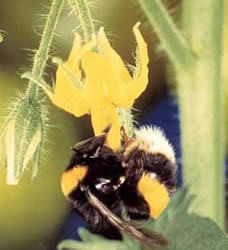
Preview
Material for Exam 2 - Fall 2007
Print
the PDF version (no pictures, better printing)
More tomatoes in your salad. Tomatoes are frequently harvested when they are still green and before they are completely ripe and red. The ripening process involves many metabolic activities that require enzymes. According to market needs, the ripening process can be regulated by adjusting the environmental temperature and by applying a plant hormone that facilitates the ripening process. A scientist was hired to measure the effect of environmental temperatures on the speed of the ripening process. He designed an experiment where he exposed different groups of green tomatoes to different temperatures and he measured the disappearance of the green color.
You keep two groups of green tomatoes in the dark. One group is maintained in the refrigerator at a low temperature (4oC) and the other group at room temperature at a relatively high temperature (24oC). You transfer your green tomato from dark to light (green tomatoes conduct photosynthesis) source
sourcePlants must be pollinated (pollen from the anthers must reach the stigma) in order to produce seeds and fruits. Tomato flowers must be vibrated at a specific frequency by wind or bees in order to release the pollen. Most honey bees do not pollinate tomatoes because they cannot vibrate the anthers at the right frequency to release the pollen from the anthers and the flowers do not produce nectar to attract them. Some native bumble bees, however, are able to produce vibrations with the frequency that releases the tomato pollen. These bumble bees feed upon the pollen and at the same time carry out the pollination process.
Depression is one of the most common health problems in the U.S. today, affecting the lives of at least 20% of the general population. New antidepressant drugs like Zoloft, Paxil, and Prozac are designed to increase the amount of the neurotransmitter serotonin that remains in the neuron-neuron synapses of the brain’s cerebral cortex. Maintaining a high synaptic serotonin concentration is critical to treating depression because significant quantities of serotonin can be reabsorbed by some patients into their pre-synaptic neurons before the serotonin ever has the opportunity to bind to the post-synaptic neuron’s receptors.


As a young pharmacologist, you synthesize a new drug, euphorin, that you observe causes serotonin molecules to bind more frequently to post-synaptic neuron membrane receptors in depressed patients. You suggest that, following medication with euphorin, you can correlate a person’s mental health state with euphorin blood levels.
 source
sourceMarsupial mammals inhabit the island continent of Australia. They are distinct from other mammals because they lack a placenta and their young develop inside a pouch. During the Permian Period (225 million years ago), Earth’s land mass was a single giant continent called Pangaea, where all ancestral terrestrial animals lived. When continental drift split Pangaea into smaller continents, it is hypothesized that a population of “ancestral marsupials” lived in Australia. The 3 marsupial species shown in the picture below illustrate the diversity of present-day marsupials: the kangaroo has powerful long legs and roams the dry plains; the koala, with a smaller body and claws, is a tree-climbing herbivore that feeds on eucalyptus leaves; the wombat is a furry, plump, rodent-like burrower that is able to survive in much colder climates than the other two marsupials.

 source
source source
sourceIn order to study the response of neurons, scientists use a technique called a whole-cell patch clamp. These instruments have a sensor that can measure the relative charge within the cell as compared to outside of the cell. In the test system shown in the diagram below, a stimulus can be applied that starts an action potential and the sensors can measure the relative charge over time. In this test system, Sensor A is located prior to a synapse and Sensor B is located after a synapse.

 source
sourceMost aquatic animals can only live in either saltwater or in freshwater, depending on the physiology of the animals. However, a species of fairy shrimp that lives in temporary ponds can survive in environments that range from fresh water with low salt content (~50 mg/L) to very saline water that has a high salt content (~500 mg/L). Fairy shrimp have an internal salt concentration of ~200mg/L. They maintain their internal salt concentration by using sodium and calcium pumps that move sodium and calcium against a gradient. The ability to tolerate differing salt levels is important as many of the ponds available to them start off as fresh water following spring rains and gradually evaporate during the summer leaving water that is saline. Once the pond is dry, they form cysts and survive in the mud in the bottom of the pond.
 source
sourceIn the movie Kill Bill (volume 2), the character Bud was bitten by a black mamba and suffocated because the poison paralyzed his diaphragm (the muscle that moves your ribs so you can breathe). Black mamba toxin causes paralysis and is beneficial in killing either prey or potential predators of the snake. It can kill a person, but it takes 7-14 hours (not a few minutes!). Scientists interested in the black mamba toxin research how the amount of toxin in the bloodstream affects muscle control.
 source
sourceThe yucca plant is a short shrub that grows in hot, dry areas. During the summer months it produces large clusters of white flowers that attract the yucca moth. Close relatives of the plant do not produce these flowers. The yucca moth is the only known pollinator of the yucca plant. These moths have specialized mouthparts, called palps, which allow them to collect the sticky pollen. During development, the moth caterpillars eat only yucca seeds. Yucca moths rely on these plants for their survival just as the plants rely on the moths.
 source
source source
source source
source